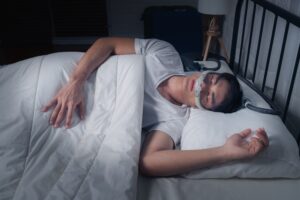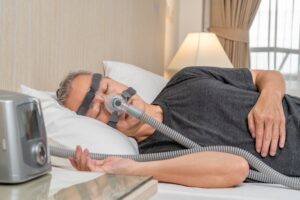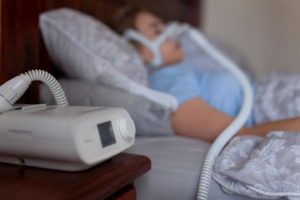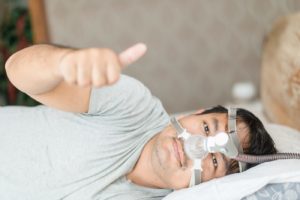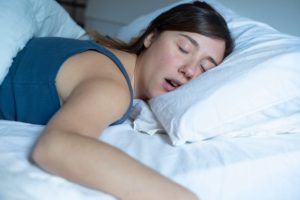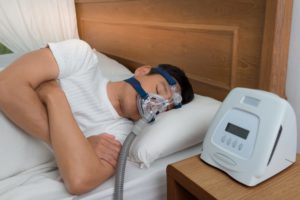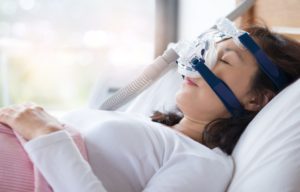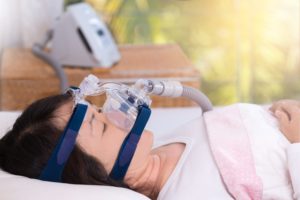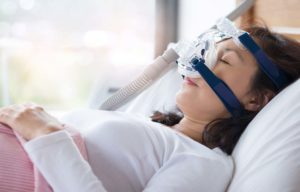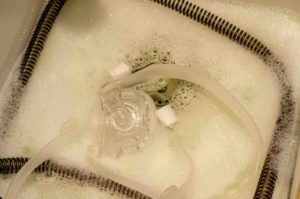How to Put on a CPAP Mask: Our Guide to Finding Your Best Fit
If you’ve never used a continuous positive airway pressure (CPAP) machine, putting on a CPAP mask might feel confusing and overwhelming. A CPAP mask that fits correctly is both secure and comfortable, but getting the right fit can sometimes be difficult if you don’t have a guide.
To help you get the right fit — which is critical for both your comfort and your treatment’s efficacy — we’ll walk you through the process with step-by-step instructions. We’ll also introduce you to other information you should know, such as the different parts of a CPAP mask, and provide helpful tips for wearing and adjusting to your new mask.
What Mask Do You Have? CPAP Mask Types
Each type of CPAP mask has a design that meets specific needs and requires a different technique for putting it on correctly. It’s important to use a mask type that matches your needs, including your preferred sleep position, since the wrong mask type can make PAP therapy uncomfortable or even ineffective.
Nasal Masks
Nasal CPAP masks direct pressurized air through your nose while leaving your mouth free. Although most nasal masks cover the whole nose — starting at the bridge of your nose and ending above your upper lip — there are also nasal cradle styles that leave most of your nose exposed.
Nasal masks are one of the most popular CPAP mask styles and work well for a wide range of people. Lower-profile nasal masks are particularly useful for people who wear glasses or like to watch TV before bed.
Nasal Pillow Masks
Nasal pillow masks gently inflate inside of your nostrils to create a seal, which directs air through your nose while minimizing skin contact.
As the lightest and most streamlined of CPAP mask styles, nasal pillow masks are a popular choice for people who find other masks claustrophobic. They can also make it easier to sleep on your stomach or side.
Full Face Masks
Full face CPAP masks direct air through both your nose and mouth. Most start at the bridge of your nose and end below your lower lip, but some compact versions leave most of your nose free.
Full face masks are the best choice for people who breathe through their mouth during sleep. They are also more comfortable than most nasal styles for people who have a high air pressure prescription.
What’s in a Mask? CPAP Mask Parts
Although CPAP masks can look very different from one another, almost all of them have some very important components in common. If you’re not sure which part is which on your mask, the manufacturer’s instructions probably include a useful diagram of the different parts.
| CPAP Mask Part | Description |
|---|---|
| Frames | A CPAP mask’s frame is what holds it all together. Other parts either clip or snap into the frame, which is usually made of a hard material to provide stability. |
| Headgear | Your CPAP mask has headgear to keep it on your face. Headgear can vary significantly between designs, but it usually involves one or more straps that go around the back of your head. |
| Cushions | Full face and nasal CPAP masks use a cushion to create a seal against your skin. The cushion is usually made from silicone or foam. |
| Pillows | Nasal pillow CPAP masks use a set of pillows instead of a cushion. The pillows, which inflate inside your nostrils, are usually made from silicone or gel. |
| Tubing connection | CPAP masks have different ways to connect your CPAP tubing to your mask. Swiveling elbows, for example, connect at 90 degrees and allow for greater freedom of movement. |
Preparation Phase: Before You Wear Your Mask
Preparing yourself, your room, and your equipment before going to bed is an easy way to cut down on CPAP-related aggravation. These steps will likely become second nature as you get used to using your CPAP machine.
Check Your Equipment
Before putting on your mask, you should double-check that it is clean and assembled correctly. You should also make sure that your CPAP machine itself is in good condition, on a stable surface, and that there is nothing blocking any of its vents.
Set Up Your Bedroom
Falling asleep while wearing a CPAP mask is easiest when your bedroom is set up to help you sleep well. A dark, cool bedroom helps tell your body that it’s time to sleep, while keeping the humidity at a comfortable level can help reduce the risk of condensation in your CPAP tubing.
It’s also important to make sure you have space for your CPAP equipment. There should be no obstructions between you and your CPAP machine, and your tubing should be corralled so that you don’t get tangled in it during the night.
Prepare Your Face
Your face should be clean and dry before you put your CPAP mask on. Unabsorbed lotion and oil can damage your equipment and make it harder to get a good seal, so you might want to consider moisturizing earlier in the evening.
If you have facial hair, remember to choose a CPAP mask that works with it and keep it well-trimmed.
Putting On a CPAP Mask: Step-by-Step
The more you use your CPAP mask, the more comfortable putting it on will become. You might want to put your mask on in front of a mirror at first so that it’s easier to see what you’re doing.
Step 1: Mask Assembly
Your mask should be clean and correctly assembled before you put it on. Most manufacturers include assembly instructions with the mask or offer instructions on their website.
Step 2: Mask Positioning
Different mask types need to be positioned in different ways:
- Full-size nasal masks should rest against the bridge of your nose without any gaps or extra pressure, and should rest above your upper lip without crowding your nostrils
- Nasal cradle-style masks should tuck in between your nostrils and upper lip without digging in anywhere
- Nasal pillows slip into your nostrils, so they should look balanced and even with the rest of your face when you look in the mirror
- Traditional full face masks should be centered between the bridge of your nose and the middle of your chin, while compact styles shouldn’t put any pressure on your upper teeth or nostrils
Step 3: Securing the Mask
Once your cushion or pillows are aligned, you should follow the manufacturer’s instructions on how to secure and adjust your mask’s headgear.
A secure fit shouldn’t feel like the mask is digging into your face, since over-tightening can actually cause leaks. A mask that fits properly will feel comfortable but won’t feel loose, and won’t shift when you turn your head, lay down, or change positions.
Step 4: Connecting the Tubing
Almost all CPAP tubing has a standard 22-millimeter cuff that should slip over the mask port snugly and completely. Soft, flexible cuffs can be easier to work with than hard cuffs, so you might want to use a soft adapter if your hose has a hard cuff.
Step 5: Test Your Mask
To test your mask for leaks, turn on your CPAP machine and make sure the settings are correct. You might have a leak if you hear a loud or sharp hissing noise, or if you feel a jet of air against your skin or near your eyes. Some CPAP machines also include a leak detection feature.
Step 6: Last-Minute Adjustments
A leaking mask is usually under or over-tightened, or isn’t positioned correctly. Adjusting your headgear will solve many mask leaks, but if that doesn’t work you may want to take the entire mask off so that you can reposition it on your face.
Hot Tips for a Comfortable Mask Fit
There are lots of tricks for using a CPAP mask. You’ll likely discover some of them with time, but here are some important tips to help get you started.
Keep an Eye Out for Common Mistakes
If your mask keeps leaking no matter what you do, it might be the wrong size. Most manufacturers offer printable fit guides that can help you decide on the right cushion, pillow, or headgear size.
Many people try to make up for an incorrect mask size, or a poorly positioned mask, by over-tightening their headgear. Headgear that is too tight will not fix these issues and can cause your mask to leak even if it fits correctly.
Use CPAP Mask Liners
CPAP mask liners are fabric barriers that fit around your mask cushion or pillows to minimize contact with your skin. Some people find that liners are more comfortable and help protect their skin from irritation. Liners can also help keep your equipment clean by protecting it from skin oil and debris.
Address Mask Leaks
Bad leaks can be uncomfortable and noisy, but even barely-noticeable leaks can make your CPAP therapy significantly less effective.
Your CPAP machine is calibrated to deliver the air pressure level that will keep your airways open during sleep. Leaks lower the air pressure level, which means that you might experience apnea events even while using your CPAP machine.
Prevent Skin Irritation
Choosing a mask that suits your needs and fits properly is the best way to prevent irritation, but there are other tricks that can help you protect your skin:
- Make sure both your skin and equipment is clean before putting on your mask
- Choose a cushion material that your skin doesn’t react to, or use a fabric mask liner
- Use a moisturizer that absorbs completely and give it time to sink in
- Ensure that your headgear is properly adjusted and not too tight
Get Used to Wearing Your Mask
Even if your mask fits correctly, it might still feel strange or even uncomfortable until you adjust to the feeling of wearing it. Wearing it during the day, particularly if you pair it with relaxation techniques, can help desensitize you to the feeling.
If your mask fits well but you continue to feel uncomfortable, or if you experience claustrophobia, your doctor might have further advice to help relieve your discomfort.





